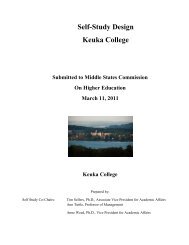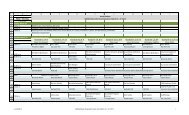final version of the self-study document - Keuka College's Middle ...
final version of the self-study document - Keuka College's Middle ...
final version of the self-study document - Keuka College's Middle ...
You also want an ePaper? Increase the reach of your titles
YUMPU automatically turns print PDFs into web optimized ePapers that Google loves.
with <strong>the</strong> expectation that this feedback will lead to stronger analysis and use <strong>of</strong><br />
assessment results.<br />
Future Gen Ed Assessment Plans: With <strong>the</strong> addition <strong>of</strong> our newly hired Director <strong>of</strong><br />
Institutional Assessment, we will be working more closely with all Gen Ed faculty to<br />
improve overall assessment <strong>of</strong> student learning. There is concern that we simply have<br />
too many Gen Ed goals; condensing or reducing <strong>the</strong>se goals may enhance our assessment<br />
efficiency, increase student learning, and make <strong>the</strong> system work better. However, this<br />
will necessitate considerable faculty work and involvement, and <strong>the</strong> goals have already<br />
been reworked as recently as 2008. In <strong>the</strong> meantime, <strong>the</strong> Curriculum Committee will<br />
continue to implement <strong>the</strong> assessment plan and cycle for <strong>the</strong> general education outcomes.<br />
Program Assessment <strong>of</strong> Student Learning<br />
Much work has been devoted to better articulation <strong>of</strong> each academic program’s goals.<br />
The pr<strong>of</strong>essional programs (i.e., Social Work, Occupational Therapy, Education,<br />
Business, and Nursing) have long had in place well-articulated program goals,<br />
performance indicators, and assessment processes, whereas programs in <strong>the</strong> nonpr<strong>of</strong>essional<br />
divisions (e.g., Natural Sciences and Ma<strong>the</strong>matics, Humanities and Fine<br />
Arts, Basic and Applied Social Sciences) have more variation in <strong>the</strong>ir programs’ goals<br />
and assessment. As depicted in assessment plan diagram (Appendix 4.17 Assessment <strong>of</strong><br />
Student Learning Plan Diagram), Program Goals are integrated with both <strong>the</strong> Gen Ed and<br />
E-LEAP goals. Appendix 4.23 Program & Gen Ed Course Alignment Examples shows<br />
examples <strong>of</strong> how Program courses are aligned and sequenced with Gen Ed courses, and<br />
Program and E-LEAP alignment is discussed below in <strong>the</strong> E-LEAP Assessment section<br />
(See Appendix 4.35 E-LEAP and Programs Goals Alignment for examples <strong>of</strong> Program<br />
and E-LEAP goals alignment).<br />
Although program level assessment <strong>of</strong> student learning has been ongoing since <strong>the</strong> late<br />
1990s, its effectiveness has varied by program over this time. Building upon a number <strong>of</strong><br />
assessment templates that had been updated in 2008 but which were used inconsistently,<br />
<strong>the</strong> AVPAP and <strong>the</strong> GO Team in 2011 created a joint-purpose assessment kit for use by<br />
all academic programs to reduce this variation in program assessment and better align E-<br />
LEAP and program-specific learning goals. The set <strong>of</strong> <strong>document</strong>s called, “E-LEAP and<br />
Program Assessment” (Appendix 4.36 E-LEAP & Program Assessment with Learning<br />
Opportunities Packet v4.2) was distributed to all Division Chairs and Program Directors<br />
at <strong>the</strong> beginning <strong>of</strong> <strong>the</strong> 2011 spring academic semester. The set <strong>of</strong> <strong>document</strong>s included<br />
<strong>the</strong> assessment plan diagram, an “Essentials <strong>of</strong> Assessment” packet, and a set <strong>of</strong> learning<br />
assessment tools intended to help programs conduct meaningful learning assessment.<br />
The Essentials packet was composed <strong>of</strong> four parts: (1) an E-LEAP and Program goals<br />
alignment matrix that linked institutional learning outcomes and program outcomes, (2) a<br />
learning opportunities matrix template (curriculum mapping), (3) an assessment cycle<br />
matrix, and (4) an assessment report template. This packet was designed to ensure each<br />
program had well-articulated learning goals that were aligned to <strong>the</strong> E-LEAP goals, a<br />
curriculum map and time-based plan <strong>of</strong> <strong>the</strong>ir learning goals associated with <strong>the</strong>ir courses<br />
and/or activities, and a common template to report <strong>the</strong>ir assessment findings. While <strong>the</strong>se<br />
Page 17 <strong>of</strong> 31 Chapter 4: Inst. Effectiveness & Assessment




